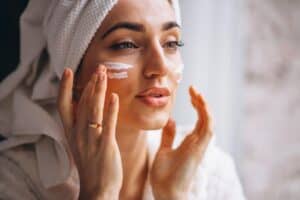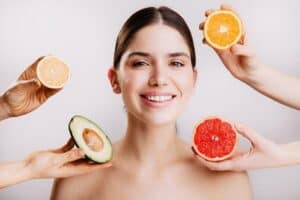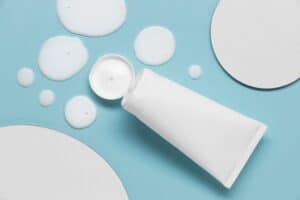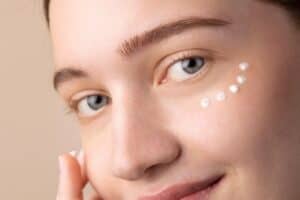Several people have mastered the art of achieving a smooth and dewy complexion which looks almost clear like glass. The glass skin trend which emerged from Korean skincare has developed a crucial process for achieving its popularity. The strategy behind glass skin involves both deep moisture and strengthening the natural skin barrier rather than using short-lived makeup effects. Research shows that shiny, young-looking skin develops from moist skin with an intact natural barrier. What sets Allynonews apart from other sources is its modern approach to sharing proven beauty knowledge. This guideline will introduce you to scientific rules together with professional advice and exceptional products for achieving glass skin quality independently from your skincare background.
1. Understanding the Glass Skin Phenomenon
A skin surface characterized by glass quality exists when it is smooth with plumpness and high hydration, capable of reflecting light. To achieve glass skin one must preserve both the barrier function and general well-being of the skin on par with standard skincare routines. The combination of an effective lipid barrier together with proper hydration stops the escape of water through the skin (TEWL) to preserve skin dewiness.
Key Characteristics of Glass Skin:
-
The surface of the skin remains completely smooth since there are no noticeable lumps nor pores nor rough areas.
-
The skin stays hydrated at every time point throughout the day and shows a dewy appearance without any dryness.
-
The appearance of a radiant glow indicates proper hydration because it shows as a fine natural sheen without becoming excessively oily.
-
Sufficient moisture retention leads to a firm and plump physical state while creating a youthful buoyant appearance.
Skincare approaches and sustainable improvements take precedence for glass skin due to its distinct approach versus the prevailing makeup trends
2. The Science Behind Hydration and Skin Barrier Function
A damaged skin barrier causes dehydration alongside inflammation and dull skin appearance, based on research. Through its barrier function, the stratum corneum maintains internal moisture content while blocking outside irritants.
Key Hydrating Ingredients for Glass Skin:
-
Hyaluronic Acid: Water absorption capacity of hyaluronic acid reaches 1000 times its weight, which aids skin in maintaining its plump texture.
-
Glycerin: A humectant behaves as a substance which draws moisture toward skin surfaces.
-
Ceramides: These substances improve skin’s protective abilities and minimize water evaporation.
-
Panthenol (Vitamin B5): The ingredient delivers comprehensive moisture treatment to gentle dry skin which needs soothing.
Such substances boost skin texture alongside moisturization levels and create skin brightness.
3. Essential Steps to Achieve Glass Skin
Most individuals follow several methodical steps to achieve and maintain glass skin. The necessary procedure comprises the following breakdown:
Step 1: Double Cleansing
A two-step washing procedure accompanied by regular oil removal enables effective sunscreen and debris and makeup removal from the skin’s surface.
-
Oil-Based Cleanser: Dissolves contaminants and makeup.
-
Water-Based Cleanser: Removes sweat.
Step 2: Gentle Exfoliation
The skin renewal process, along with pore clearing and texture smoothing, benefits from two exfoliating acids known as salicylic acid (BHA) and glycolic acid (AHA).
Step 3: Hydrating Toner & Essence
The essence deeply nourishes the skin while also making it more elastic, and a light, hydrating toner helps prepare it for the next step.
Step 4: Targeted Serums & Treatments
Skin becomes brighter and stronger while developing enhanced resistance to oxidative stress when people apply niacinamide with vitamin C and peptides.
Step 5: Deep Hydration with Moisturizer
The skin stays hydrated and prevents water loss through the protective layer because of ceramide-rich moisturizers.
Step 6: Sunscreen for Protection
Exposure to UV radiation accelerates aging and causes skin dullness and hyperpigmentation but using sunscreen daily with an SPF rating at least 30+ can avoid these effects.

4. Foods That Promote a Healthy Glow
The condition of your skin surface and its shine depends heavily on the foods you consume. Skin texture alongside elasticity improve significantly when people maintain a nourishing diet consisting of antioxidants and good fats, and hydrating nutrients.
Best Foods for Glass Skin:
-
Vitamin C-Rich Foods The consumption of bell peppers, along with citrus fruits, promotes collagen formation in the body.
-
Omega-3 fatty acids The skin’s defense systems receive stimulation through the consumption of flaxseeds and salmon.
-
Antioxidant-rich foods (green tea, berries): Prevent oxidative damage.
-
Hydrating foods (watermelon, cucumber): Preserve moisture content.

5. Common Skincare Mistakes That Prevent Glass Skin
The skin barrier suffers unintentional harm, which results in dryness and dullness as well as breakouts for numerous individuals.
Mistakes to Avoid:
-
Over-exfoliating – When the protective layer of the skin weakens, it leads to inflammation.
-
Skipping sunscreen – Your skin develops an irregular shading pattern, along with more noticeable signs of aging as a result of UV radiation exposure.
-
Using harsh products – Strong foaming cleansers and toners with alcohol extract moisture.
-
Ignoring hydration – Dehydrated skin develops a dull appearance, along with discolored skin areas.
For a successful glass skin appearance, one must follow a skincare routine of hydrating products which use gentle ingredients.
6. Lifestyle Habits for a Lasting Glow
Your physical and mental health receive everyday protection, and your skin stays hydrated through self-care activities.
Best Practices for Radiant Skin:
✅ Get 7-9 hours of sleep. At night, skin regenerates.
✅ Manage stress –Apart from dullness and breakouts, corticosteroid hormones trigger these issues.
✅ Stay hydrated – Drinking water in amounts exceeding eight glasses makes up the daily routine.
✅ Exercise regularly – Increases the skin’s oxygen and blood flow.
Your skin texture, along with its brightness, will improve through the combination of skincare routines with lifestyle adjustments.
7. Best Skincare Ingredients for Glass Skin
Dermatologists recommend adding these three elements for maximum results achievement:
-
Hyaluronic Acid – Plumps and deeply moisturizes skin.
-
Niacinamide – Lessens and brightens redness.
-
Vitamin C – The treatment enhances radiance while it makes dark spots appear lighter.
-
Peptides – Collagen synthesis will rise to produce both firmness and youthfulness in the skin.
-
Centella Asiatica – Barriers against environmental stress increase while inflammation decreases.
Substances backed by scientific evidence ensure results which persist over time and remain visible to the eye.

8. Signs Your Skin is on the Path to Glass Skin
The skincare regimen works only under these conditions:
✨The skin’s appearance includes softness with natural radiance along with overall plumpness.
✨ The material displays a smooth and silky consistency.
✨ No severe redness, dryness, or breakouts.
✨ The natural dewy appearance of skin occurs without any oil.
Barrier-strengthening substances combined with hydration level modifications should be used in cases of long duration.

Conclusion
The main objective for glass skin is to achieve long-lasting improvements in skin health rather than temporary zinc. Following a skincare routine based on hydration combined with a diet of nutritious food products and a balanced lifestyle will lead to smooth skin with a natural glow. Allynonews promotes skincare items that have scientific evidence to bolster internal beauty.
References
Dini, I. (2024). “Edible Beauty”: The Evolution of Environmentally Friendly Cosmetics and Packaging. Antioxidants, 13(6), 742.
Duncan, P. (2025). The glowy: the aesthetics of transparency in postfeminist “wellness” culture. Feminist Media Studies, 1-14.
Bioactive Substances and Skin Health: An Integrative Review from a Pharmacy and Nutrition Perspective. Pharmaceuticals, 18(3), 373.
Mawazi, S. M., Ann, J., Othman, N., Khan, J., Alolayan, S. O., Al thagfan, S. S., & Kaleemullah, M. (2022). A review of moisturizers; history, preparation, characterization and applications. Cosmetics, 9(3), 61.


